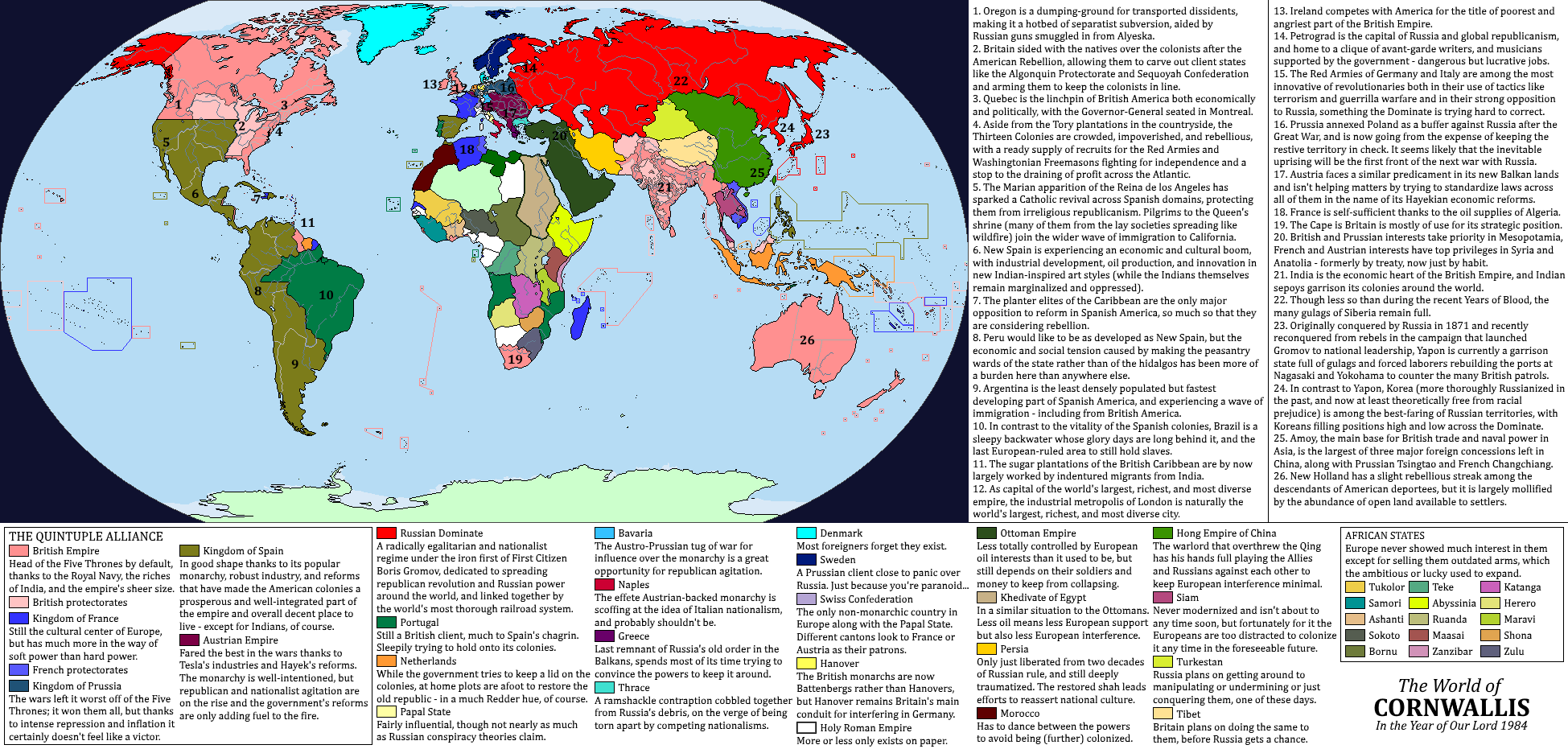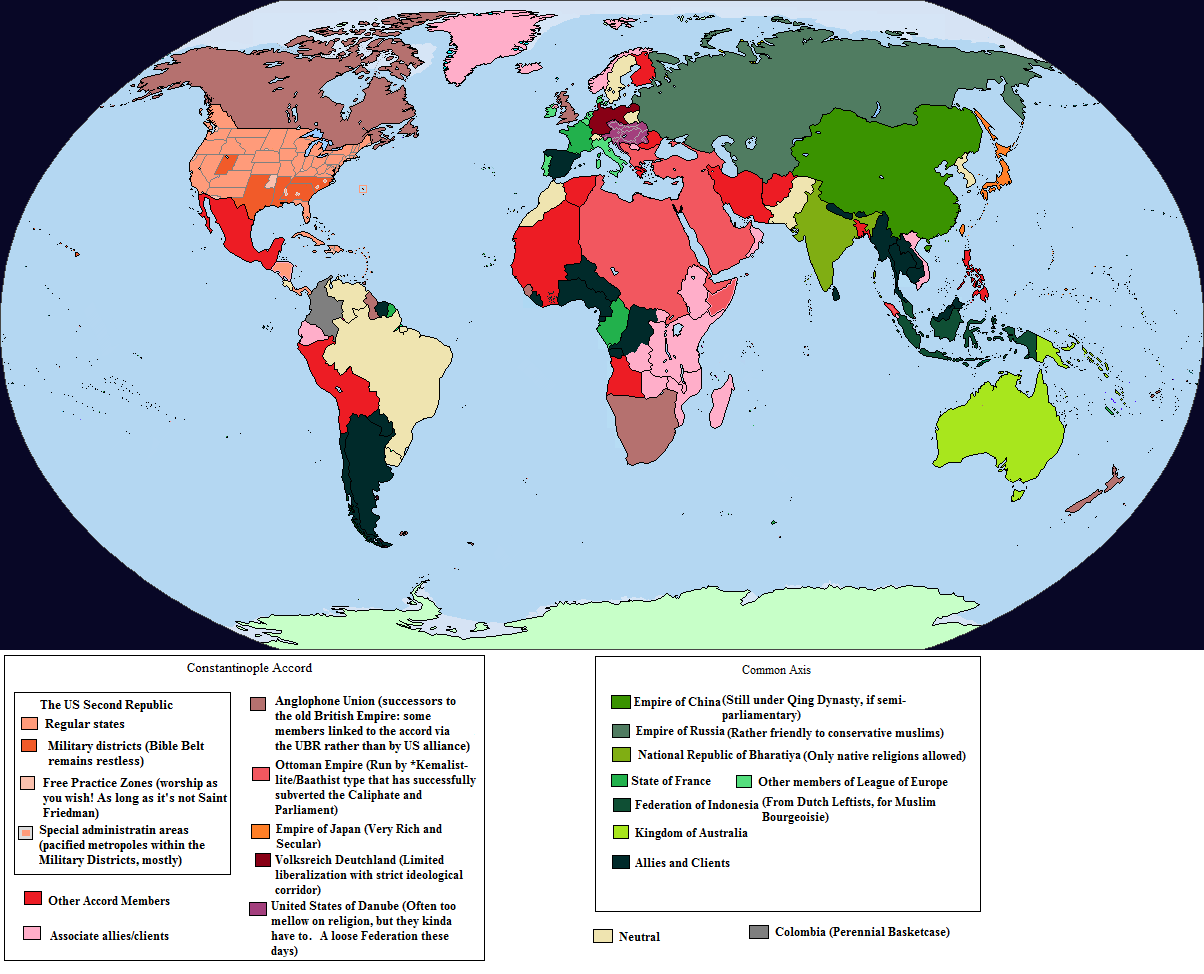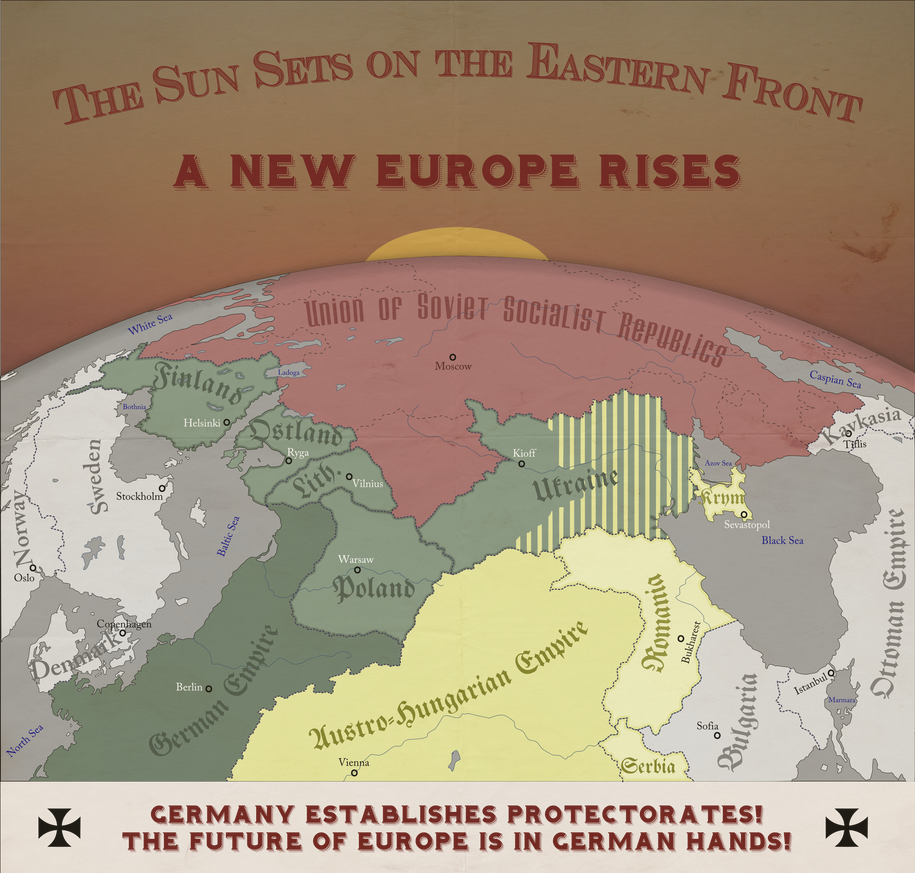A Map and Description of Europe in the year CY 150 of
Bring Me Men To Match My Mountains (my own take on the Emberverse set 150 years after the Change)
Can Be Found Here
Europe was pretty badly devastated by the Change and the chaos that followed, like much of the developed world. Today however, the population is recovering, industry is only the rise, and the same social, economic, and political changes that are so transforming North America are present here as well.
The largest state in Western Europe is the United Kingdom, the flagship of the New British Empire (in truth the NBE is an economic empire, rooted on a coalition of constituent dominions with a mutual defense treaty, a free trade agreement, a common currency, and a few small islands and Sovereign Base Areas controlled by the Royal Navy thrown in). An emergency government managed to bring 1.8 million Britons through the Change through a combination of geography, skill, and very good luck, the UK then leveraged its very good Post-Change starting position into resuming its status as a world power (for more details check out my TL). The colonization of continent was gradual, initially quite a few French, German, and Spanish survivors migrated to the starting outposts in search of law, order, and a standard of living higher than that in the wilderness proper. Most of these assimilated, but as the British colonists pressed further into the interior they began to encounter larger, more organized statelets and groups of survivors (or rather their descendants) who fought against the encroachment into their lands. The British response was to conquer most of these groups and incorporate them into the UK by force. Eventually, faced with the threat of total conquest many of the smaller western European states joined together, resulting in the formation of La Mancha, Euskal Herria, and the Kingdom of France, which were strong enough and populous enough to resist successfully. La Mancha only recently had a puppet ruler installed by the British, there’s no expectation of it being annexed to the UK however- too big and too Spanish to integrate. There are still substantial French, Spanish, and German populations in the UK, but they are minorities in the British controlled parts of all three of those former countries (although they do make up local majorities in places like central France and the less agriculture friendly bits of Spain).
The capital of the UK has been back in a rebuilt London for the past decade, but in terms of population and industry the center of the country has shifted to the continent where the new industrial revolution thrives on water power driven by the Rhine, the Seine, and other rivers.
Quite a lot of Ireland survived as well, away from Belfast and Dublin the population density was low and agriculture common. Initially local government came together, organizing an emergency “Provisional Republic of Ireland” based out of Athlone. However the PRI fell under the control of a charismatic and powerful dictator, causing the city of Limerick as well as a number of towns along the River Shannon to break away and create a rival Irish government. Although officially named “Eire” and a rival for the title of legitimate government of Ireland, geography caused the Limerick based government to be known as the “Republic on the Shannon” (later the "Republic
of the Shannon")- a moniker it kept even though it ended up losing control over most of the river itself. The PRI is a rogue state even for this world (it has its own Pope among other things) and is a hereditary dictatorship with a cult of personality around the Provisional President. It has successfully resettled the area around Dublin and defeated efforts by the UK to resettle Ulster, expelling surviving Irish Protestants within the territory under its control (most of whom immigrated to the UK). The Republic of the Shannon is a fairly normal, functioning democracy, allied with the UK and heavily armed as its neighbor to the north has tried repeatedly to conquer it. The Shannon has a colony on the East Coast of North America and its government once fled there temporarily during a war a generation ago with the PRI when it appeared as though Limerick was in danger of falling (it didn’t).
While most of the population of Scandinavia died of starvation following the Change, quite a few people survived in isolated regions, islands, and rural areas. Iceland, Greenland, and the Faeroe Islands came through the Change quite well, with low populations and a combination of rationing and fishing they were able to avoid any real starvation. Greenland and the Faeroes subsequently decided not to resurrect the Kingdom of Denmark (which they were autonomous countries of) and instead made a go of it on their own as independent states. In mainland Scandinavia a number of local and provincial governments survived in northern Sweden and Finland, quite a few Baltic islands- including Danish and Finnish islands such as Bornholm and the Aaland Islands- did well. Norway’s terrain also hid quite a few towns and small communities. In the years after the Change surviving Scandinavian local and provincial authorities co-operated with each other, providing mutual assistance that ranged from sharing food surplus to joint operations against bandits and warlords, to the resettlement project in Denmark and Southern Sweden where a large number of immigrants from Iceland (which could not support its full population for the long-term) and a handful from the Faeroes ended up residing. This informal co-operation was gradually formalized, eventually absorbing the projects to re-establish national governments. The Baltic Mutual Assistance Council became the Nordic Mutual Assistance Community, which together with the re-established Nordic Council and the Scandinavian Economic Co-Operation Zone eventually morphed into the Scandinavian Union in CY 96. The SU is a loose confederation with a great deal of autonomy for its members, most of whom are the old Scandinavian countries having gradually reknit themselves, absorbed surviving communities, and resettled empty areas. Although friendly with the UK, the North Atlantic island countries, and Estonia, the SU is most inward looking and isolationist- they still have a very low population density and a lot of territory to resettle.
Estonia is mostly descended from some 60,000 people who survived in the Estonian Islands and later moved back in to resettle the Baltic States, absorbing or defeating most other survivors in the area. Like Scandinavia they remain heavily rural and agricultural.
While the Portuguese government and most of the Portuguese population died after the Change, there were survivors particularly in the Azores. They organized an emergency Portuguese government there, and later when they made contact with the British, London (actually it was Douglas, Mann at that point in time) helped them to gradually regain control to the Portuguese mainland. The capital remains in Ponta Delgada (this is a theme you’ll hear a lot of) as Portugal proper is still lightly populated and mostly agricultural. Portugal remains closely allied to Great Britain, and it is worth noting that outside of the Azores Portuguese citizens speak English about as much as they do Portuguese.
There are five countries in Italy, the largest of which is the Umbrian League descended from a collection of surviving communities in the hills of central Umbria that now controls Northern and Central Italy. In Sicily and Southern Italy you will find the country of Sicily (just Sicily, no other descriptors) descended from survivors in the interior of that island who have also colonized a large part of former Tunisia. Both are rather oligarchic, Sicily more so than Umbria as Umbria at least holds symbolic elections and maintains the trappings of democracy. They very much do not like each other. The Emergency Administration of Corsica began as a regime in control of the town of Corte in central Corsica which unified the island and eventually incorporated Sardinia as well. Corsica is neo-feudal- its leadership is hereditary and controlled by one family- but not so neo-feudal as the Kingdom of France or Greece. The other two Italian states are Vatican City- finally restored to the Vatican, as the Papacy had fled to Umbria after the Change- and the Sovereign Military Order of Malta. The Knights held out in the fortress of St. Angelo after the Change along with as many civilians as they dared save, and later assumed control of the island of Malta proper. Currently their role in the administration of the island is mostly symbolic- an elected council of Maltese do the actual work- while Sicily is responsible for the defense and foreign relations of the country. The Maltese islands of Gozo and Comino are directly part of the Sicilian state.
Between the UK and Italy is the sprawling Alpine Confederation (which extends beyond the Alps in places). The Confederation began as a couple of surviving Swiss cantons recruiting surviving communities in the mountains to join them, and grew from there as towns, villages, statelets, and others in Switzerland, Italy, France, Germany, and other places joined up out of fear of British, Italian, and New Roman expansion. Unfortunately most of the Alpine member states are flavor of authoritarianism, ranging from neo-feudalism to old fashioned petty dictatorships (there are a few that are quite nice however). Internal politics are very Holy Roman, the national government is extremely weak, and most state functions are run on the local level by cantons and member states which function in most respects as if they were sovereign countries. The Alpine Confederation’s survival can be attributed to a few factors, notably the fact that its members have thus far been pretty good at presenting a solid block to outsiders. Its many little rulers have no desire to lose their power and privileges, after all. Go to war with one member and now you’re fighting the rest of Confederation, and it really isn’t worth the trouble to try and conquer the place when there is plenty of room elsewhere to settle and expand. That said, the country today is shakier than ever, internal conflicts threaten its unity, and many of the common people are influenced by democratic ideals flowing across the border from the UK.
On the Adriatic you have the New Roman Empire- created by a fairly strange Slovenian warlord after the Change who took over the island of Krk, did some conquering on the mainland after the population collapse finished, re-founded the Roman Empire and his successors kept the state going afterwards. (Think of him as a sort of Slovenian version of Norman Arminger, only obsessed with Romans instead of Normans). Austria is a former part of the NRE, which broke away about fifty years ago. (Like the Kingdom of France, the mixed Austro-Slovenian rulers of the Kingdom of Austria are in no way related to any pre-Change nobility.) South of the New Romans is Serbia- ironically descended from a Serbian survivor state located in former Montenegro. All three of those countries- Austria, New Rome, and Serbia- are neo-feudal, the Austrians the least and the Serbs the most (a consequence of both New Rome and the initial Serbian state allowing defeated warlords and independent communities limited autonomy within their countries in exchange for said warlords and communities surrendering and not fighting to the death).
They pale in comparison Greece, however.
Quite a few Greeks survived in the mountainous parts of central Greece and the Greek islands. These groups independently began to recolonize Greece and as time went on other surrounding territories. They fought and competed, and the Greek Federation is actually a fairly new creation. Rhodes- which is a rather direct democracy- opted out, and the federation is mostly made up of little dictatorships with varying degrees of autonomy and hereditary or pseudo hereditary leaderships. More or less the poster-child for modern day neo-feudalism, Greece combines ceremonial democracy with powerful families descended from figures who were successful after the Change and pass down their control over different offices to the next generation when they die. As with many parts of the world, ideas from the new renaissance are penetrating, and Populism- Europe’s equivalent to American Unionism- has its adherents among the Greek peasants. The Commonwealth of Cyprus- a constituent dominion of the New British Empire- wants no part of the Federation, nor does the Turkish Republic of Northern Cyprus and Asia Minor (a friendly British ally that does not in fact control all of the territory it claims to on the map).
Eastern Europe is still underpopulated, with large areas of villages and small statelets that no larger country has the population to absorb. Of note are the three cities of Eastern Europe- Poznan, Pinsk, and Vinnytsia which survived the Change. Poznan did so under a brutal regime that burned out large numbers of people and fed the living on the dead, but brought 200,000 people through the chaos, eventually absorbed the other Polish survivors and created a new Polish Republic (which is a quite genial oligarchy these days). Pinsk was conquered by a warlord of unusual competence, with a small population amid agricultural land it similarly began the germ for a new Belarus under the rule of said warlord’s descendants. Vinnytsia pulled through under the pre-Change local government and Ukraine is a fairly corrupt democracy under dominant-party rule.
Past that you get into the ruins of Russia- a predominantly Tartar Crimea under British protection (note also the Sovereign Base Area at the mouth of the Danube), the Cossack Don Host, neo-fedual Belgorod which tried to resurrect the Soviet Union, and the Russian Federation (Vologda) which is a fairly normal oligarchy under emergency rule since the Change. Plenty of other Russian states further east. There is a strong and growing movement for Russian reunification, which is generally opposed by the rulers of the various Russian states (unless of course one were to suggest that Russia be reunited under
them).






